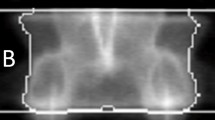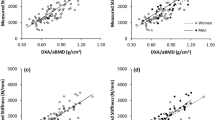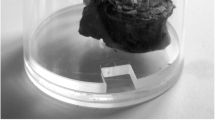Abstract
Background
Diet and exercise can promote weight loss in older adults; however, there is potential to increase fracture risk due to loss of bone mineral density (BMD) known to accompany weight loss. Weight loss effects on measures of bone quality and strength are currently unknown.
Aims
The purpose of this study is to develop subject-specific finite-element (FE) models of the lumbar spine and study the effect of intentional weight loss on bone strength in a pilot data set.
Methods
Computed tomography (CT) scans of the lumbar spine of 30 overweight and obese (mean BMI = 29.7 ± 3.9 kg/m2), older adults (mean age = 65.9 ± 4.6 years) undergoing an 18-month intentional weight loss intervention were obtained at baseline and post-intervention. Measures of volumetric BMD (vBMD) and variable cortical thickness were derived from each subject CT scan. Development of the subject-specific FE models of the lumbar spine involved model morphing techniques to accelerate the development of the models. vBMD-derived material properties and cortical thickness measures were directly mapped to baseline and post-intervention models. Bone strength was estimated through simulation of a quasi-static uniaxial compression test.
Results
From baseline to 18-month post-weight loss intervention, there were statistically significant decreases in estimated bone strength (6.5% decrease; p < 0.05). Adjusting for baseline bone measures and gender revealed no statistically significant correlations between weight change and change in vBMD, cortical thickness, or bone strength.
Conclusion
Integration of CT-based measures and FE models with conventional areal BMD can improve the understanding of the effects of intentional weight loss on bone health.



Similar content being viewed by others
References
Davies K, Stegman M, Heaney R, et al (1996) Prevalence and severity of vertebral fracture: the saunders county bone quality study. Osteoporis Int 6:160–165
Nevitt MC, Ettinger B, Black DM, et al (1998) The association of radiographically detected vertebral fractures with back pain and function: a prospective study. Ann Intern Med 128:793–800
Al-Sari U, Tobias J, Clark E (2016) Health-related quality of life in older people with osteoporotic vertebral fractures: a systematic review and meta-analysis. Osteoporis Int 27:2891–2900
Crandall CJ, Yildiz VO, Wactawski-Wende J, et al (2015) Postmenopausal weight change and incidence of fracture: post hoc findings from women’s health initiative observational study and clinical trials. BMJ 350:h25
Villareal DT, Fontana L, Weiss EP, Racette SB, Steger-May K, Schechtman KB, Klein S, Holloszy JO (2006) Bone mineral density response to caloric restriction–induced weight loss or exercise-induced weight loss: a randomized controlled trial. Arch Intern Med 166:2502–2510
Villareal DT, Fontana L, Das SK, et al (2016) Effect of two-year caloric restriction on bone metabolism and bone mineral density in non-obese younger adults: a randomized clinical trial. J Bone Miner Res 31:40–51
D’Elia G, Caracchini G, Cavalli L, et al (2009) Bone fragility and imaging techniques. Clin Cases Miner Bone Metab 6:234–246
Bouxsein ML, Seeman E (2009) Quantifying the material and structural determinants of bone strength. Best Pract Res Clin 23:741–753
Engelke K, van Rietbergen B, Zysset P (2016) FEA to measure bone strength: a review. Clin Rev Bone Miner Metab 14:1–12
Siris ES, Chen Y-T, Abbott TA, et al (2004) Bone mineral density thresholds for pharmacological intervention to prevent fractures. Arch Intern Med 164:1108–1112
Netelenbos J, Lems W, Geusens P, et al (2009) Spine radiographs to improve the identification of women at high risk for fractures. Osteoporis Int 20:1347–1352
Hangartner TN, Johnston CC (1990) Influence of fat on bone measurements with dual-energy absorptiometry. Bone Miner 9:71–81
Brinckmann P, Biggemann M, Hilweg D (1989) Prediction of the compressive strength of human lumbar vertebrae. Clin Biomech 4:iii–i27
Cheng XG, Nicholson PH, Boonen S, et al (1997) Prediction of vertebral strength in vitro by spinal bone densitometry and calcaneal ultrasound. J Bone Miner Res 12:1721–1728
Edmondston S, Singer K, Day R, et al (1994) In-vitro relationships between vertebral body density, size, and compressive strength the elderly thoracolumbar spine. Clin Biomech 9:180–186
McBroom R, Hayes W, Edwards W, et al (1985) Prediction of vertebral body compressive fracture using quantitative computed tomography. J Bone Jt Surg Am 67:1206–1214
Mosekilde L, Bentzen S, Ørtoft G, et al (1989) The predictive value of quantitative computed tomography for vertebral body compressive strength and ash density. Bone 10:465–470
Bjarnason K, Hassager C, Svendsen O, et al (1996) Anteroposterior and lateral spinal DXA for the assessment of vertebral body strength: comparison with hip and forearm measurement. Osteoporis Int 6:37–42
Myers BS, Arbogast KB, Lobaugh B, et al (1994) Improved assessment of lumbar vertebral body strength using supine lateral dual-energy X-ray absorptiometry. J Bone Miner Res 9:687–693
Imai K, Ohnishi I, Bessho M, et al (2006) Nonlinear finite element model predicts vertebral bone strength and fracture site. Spine 31:1789–1794
Crawford RP, Cann CE, Keaveny TM (2003) Finite element models predict in vitro vertebral body compressive strength better than quantitative computed tomography. Bone 33:744–750
Buckley JM, Loo K, Motherway J (2007) Comparison of quantitative computed tomography-based measures in predicting vertebral compressive strength. Bone 40:767–774
Kopperdahl DL, Aspelund T, Hoffmann PF, et al (2014) Assessment of incident spine and hip fractures in women and men using finite element analysis of CT scans. J Bone Miner Res 29:570–580
Matsumoto T, Ohnishi I, Bessho M, et al (2009) Prediction of vertebral strength under loading conditions occurring in activities of daily living using a computed tomography-based nonlinear finite element method. Spine 34:1464–1469
Imai K, Ohnishi I, Yamamoto S, et al (2008) In vivo assessment of lumbar vertebral strength in elderly women using computed tomography-based nonlinear finite element model. Spine 33:27–32
Wang X, Sanyal A, Cawthon PM, et al (2012) Prediction of new clinical vertebral fractures in elderly men using finite element analysis of CT scans. J Bone Miner Res 27:808–816
Marsh AP, Janssen JA, Ambrosius WT, et al (2013) The Cooperative Lifestyle Intervention Program-II (CLIP-II): design and methods. Contemp Clin Trials 36:382–393
Rejeski WJ, Ambrosius WT, Burdette JH, et al (2017) Community weight loss to combat obesity and disability in at-risk older adults. J Gerontol A Biol Sci Med Sci. https://doi.org/10.1093/gerona/glw252
Kopperdahl DL, Morgan EF, Keaveny TM (2002) Quantitative computed tomography estimates of the mechanical properties of human vertebral trabecular bone. J Orthop Res 20:801–805
Shigeta K, Kitagawa Y, Yasuki T Development of next generation human FE model capable of organ injury prediction. In: Proceedings 21st international technical conference on the enhanced safety of vehicles, Stuttgart, Germany (2009) National Highway Traffic Safety Administration, pp 15–18
Treece GM, Poole KE, Gee AH (2012) Imaging the femoral cortex: thickness, density and mass from clinical CT. Med Image Anal 16:952–965. https://doi.org/10.1016/j.media.2012.02.008 pii]
Treece GM, Gee AH, Mayhew PM, Poole KE (2010) High resolution cortical bone thickness measurement from clinical CT data. Med Image Anal 14:276–290. https://doi.org/10.1016/j.media.2010.01.003 pii]
Bookstein FL (1997) Morphometric tools for landmark data: geometry and biology. Cambridge University Press, Cambridge
Schoell SL, Weaver AA, Urban JE, et al (2015) Development and validation of an older occupant finite element model of a mid-sized male for investigation of age-related injury risk. Stapp Car Crash J 59:359–383
Schoell SL, Weaver AA, Vavalle NA, et al (2015) Age and sex-specific thorax finite element model development and simulation. Traffic Inj Prev 16(sup1):S57–S65
Vavalle NA, Schoell SL, Weaver AA, et al (2014) Application of radial basis function methods in the development of a 95th percentile male seated fea model. Stapp Car Crash J 58:361–384
Iwamoto M, Nakahira Y, Kimpara H (2015) Development and validation of the Total HUman Model for Safety (THUMS) toward further understanding of occupant injury mechanisms in precrash and during crash. Traffic Inj Prev 16(sup1):S36–S48
Schultz A, Warwick D, Berkson M, et al (1979) Mechanical properties of human lumbar spine motion segments—part I: responses in flexion, extension, lateral bending, and torsion. J Biomech Eng 101:46–52
Begeman P, Visarius H, Nolte L-P, et al (1994) Visocelastic shear responses of the cadaver and Hybrid III lumbar spine. Stapp Car Crash J 38:1–14
Weaver AA, Nguyen CM, Schoell SL, et al (2015) Image segmentation and registration algorithm to collect thoracic skeleton semilandmarks for characterization of age and sex-based thoracic morphology variation. Comput Biol Med 67: 41–48
Weaver AA, Schoell SL, Stitzel JD (2014) Morphometric analysis of variation in the ribs with age and sex. J Anat 225:246–261. https://doi.org/10.1111/joa.12203
Schileo E, Taddei F, Cristofolini L, et al (2008) Subject-specific finite element models implementing a maximum principal strain criterion are able to estimate failure risk and fracture location on human femurs tested in vitro. J Biomech 41:356–367
Kopperdahl DL, Keaveny TM (1998) Yield strain behavior of trabecular bone. J Biomech 31:601–608
Liebschner MA, Kopperdahl DL, Rosenberg WS, et al (2003) Finite element modeling of the human thoracolumbar spine. Spine 28:559–565
Morgan EF, Bayraktar HH, Keaveny TM (2003) Trabecular bone modulus–density relationships depend on anatomic site. J Biomech 36:897–904
Silva M, Gibson L (1997) Modeling the mechanical behavior of vertebral trabecular bone: effects of age-related changes in microstructure. Bone 21:191–199
Zibellini J, Sainsbury RV, Lee CM, et al (2015) Does diet-induced weight loss lead to bone loss in overweight or obese adults? A systematic review and meta-analysis of clinical trials. J Bone Miner Res 30:2168–2178
Allison SJ, Poole KE, Treece GM, et al (2015) The influence of high-impact exercise on cortical and trabecular bone mineral content and 3D distribution across the proximal femur in older men: a randomized controlled unilateral intervention. J Bone Miner Res 30:1709–1716
Ensrud KE (2013) Epidemiology of fracture risk with advancing age. J Gerontol A Biol Sci Med Sci 68:1236–1242
Nevitt MC, Cummings SR, Stone KL, et al (2005) Risk factors for a first-incident radiographic vertebral fracture in women ≥ 65 years of age: the study of osteoporotic fractures. J Bone Miner Res 20:131–140
Shah K, Armamento-Villareal R, Parimi N, et al (2011) Exercise training in obese older adults prevents increase in bone turnover and attenuates decrease in hip bone mineral density induced by weight loss despite decline in bone-active hormones. J Bone Miner Res 26:2851–2859
Kohrt W, Bloomfield S, Little K, et al (2004) Physical activity and bone health. Position stand of the American College of Sports Medicine. Med Sci Sports Exerc 36:1985–1996
Shapses SA, Sukumar D (2012) Bone metabolism in obesity and weight loss. Annu Rev Nutr 32:287
Orwoll ES, Oviatt SK, Mann T (1990) The impact of osteophytic and vascular calcifications on vertebral mineral density measurements in men. J Clin Endocrinol Metab 70:1202–1207
Masud T, Langley S, Wiltshire P, et al (1993) Effect of spinal osteophytosis on bone mineral density measurements in vertebral osteoporosis. BMJ 307(6897):172
Homminga J, Weinans H, Gowin W, et al (2001) Osteoporosis changes the amount of vertebral trabecular bone at risk of fracture but not the vertebral load distribution. Spine 26:1555–1560
Buckley JM, Leang DC, Keaveny TM (2006) Sensitivity of vertebral compressive strength to endplate loading distribution. J Biomech Eng 128:641–646
Crawford RP, Rosenberg WS, Keaveny TM (2003) Quantitative computed tomography-based finite element models of the human lumbar vertebral body: effect of element size on stiffness, damage, and fracture strength predictions. J Biomech Eng 125:434–438
Dall’Ara E, Pahr D, Varga P, et al (2012) QCT-based finite element models predict human vertebral strength in vitro significantly better than simulated DEXA. Osteoporis Int 23:563–572
Viceconti M, Bellingeri L, Cristofolini L, et al (1998) A comparative study on different methods of automatic mesh generation of human femurs. Med Eng Phys 20:1–10
Chevalier Y, Charlebois M, Pahr D, et al (2008) A patient-specific finite element methodology to predict damage accumulation in vertebral bodies under axial compression, sagittal flexion and combined loads. Comput Methods Biomech Biomed Engin 11:477–487
Jones AC, Wilcox RK (2008) Finite element analysis of the spine: towards a framework of verification, validation and sensitivity analysis. Med Eng Phys 30:1287–1304
Schoell SL, Weaver AA, Beavers DP, et al (2018) Development of subject-specific proximal femur finite element models of older adults with obesity to evaluate the effects of weight loss on bone strength. J Osteoporos Phys Act. https://doi.org/10.4172/2329-9509.1000213
Keller T, Ziv I, Moeljanto E, et al (1993) Interdependence of lumbar disc and subdiscal bone properties: a report of the normal and degenerated spine. Clin Spine Surg 6:106–113
Buckley JM, Cheng L, Loo K, et al (2007) Quantitative computed tomography-based predictions of vertebral strength in anterior bending. Spine 32:1019–1027
Acknowledgements
We thank Divya Jain, Caresse Hightower, and Elizabeth Lopez for their assistance with data collection and analysis.
Funding
National Institutes of Health (K01 AG047921, R18 HL076441, and P30 AG21332), Wake Forest School of Medicine Translational Science Institute, Wake Forest University Translational Science Center and the National Science Foundation Research Experiences for Undergraduates (REU) under Award No. 1559700. Views expressed are those of the authors and do not represent the views of the sponsors.
Author information
Authors and Affiliations
Corresponding author
Ethics declarations
Conflict of interest
There is no conflict of interest.
Informed consent
Informed consent was obtained from all individual participants included in the study.
Ethical approval
All procedures performed in studies involving human participants were in accordance with the 1964 Helsinki declaration and its later amendments or comparable ethical standards.
Electronic supplementary material
Below is the link to the electronic supplementary material.
Rights and permissions
About this article
Cite this article
Schoell, S.L., Beavers, K.M., Beavers, D.P. et al. Prediction of lumbar vertebral body compressive strength of overweight and obese older adults using morphed subject-specific finite-element models to evaluate the effects of weight loss. Aging Clin Exp Res 31, 491–501 (2019). https://doi.org/10.1007/s40520-018-1010-1
Received:
Accepted:
Published:
Issue Date:
DOI: https://doi.org/10.1007/s40520-018-1010-1




